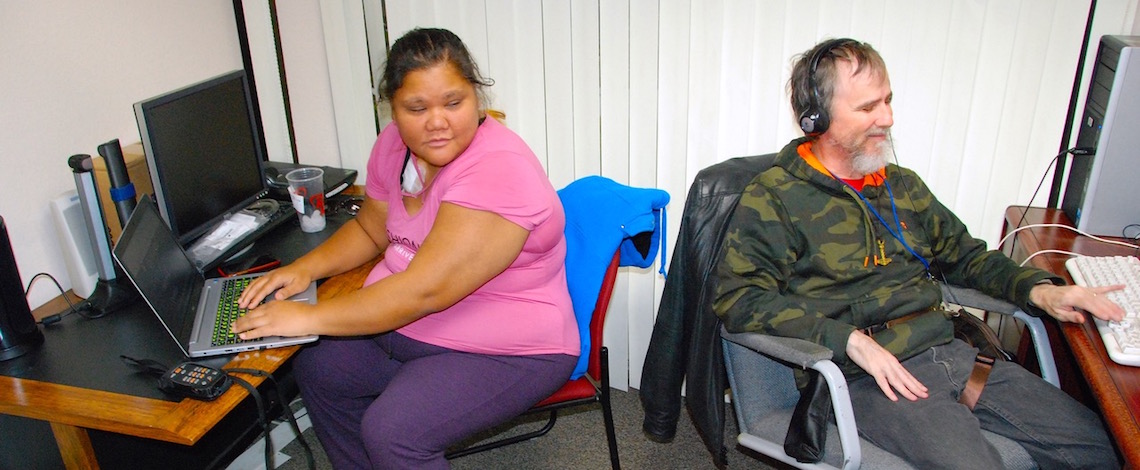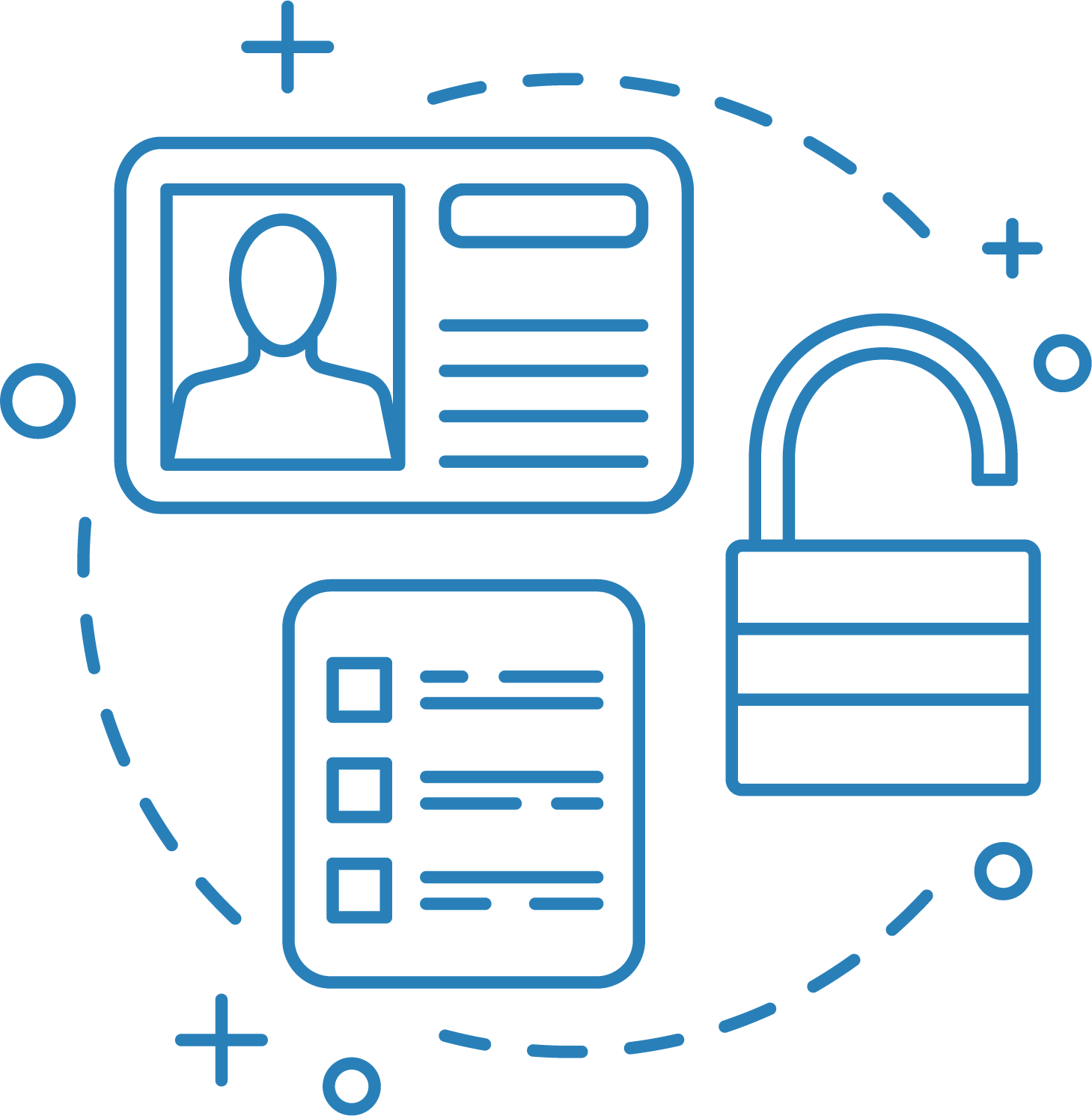
Fredrene Balanay, left, who is blind in one eye and only partially sighted in the other, undergoes training on using a computer with adaptive software for the visually impaired at Valley Center for the Blind. On the right is Tom Randall, her assistive technology instructor. 2019 File Photo
Written by David Castellon
Fredrene Balanay wants to get back to work.
She had to quit her job in her native Hawaii back in 2014 after losing all sight in her right eye due to neurovascular glaucoma, while a detached retina and macular glaucoma cost her much of the vision in her left eye.
She did work again briefly as an office assistant and editor and chief of the student newspaper at Honolulu Community College, with the help of the school’s technical staff tweaking her computers to make the words on the screen larger for her to see and fellow editors reading what was on the screen for her and editing stories at her direction.
But Balanay also had to leave that job after suffering additional health problems that also forced her to relocate from Hawaii, where she lived alone, to Fresno to live with one of her brothers.
While she currently remains unemployed, Balanay is looking to change that. Though legally — if not completely — blind, the 37-year-old has been spending a lot of time since the spring getting training at the Valley Center for the Blind, where she’s learning to work in an office job, despite her visual limitations.
She already had been working with VCB trainers to improve her living and work skills when she was referred to a new California Department of Rehabilitation-funded program provided through the VCB to help legally blind people get jobs and help those at risk of losing their jobs due to vision issues keep them.
Matching skills and need
“Clients are referred by the department, and we try to identify what skills our clients have and what they need,” said Ken Warkentin, executive director for the VCB, a non-profit that primarily provides living and job training to fully-blind and strongly visually-impaired people in Fresno, Tulare, Kings, Kern and Madera counties.
That training can range from learning to sort the money in wallets to cooking and getting around neighborhoods to learning job skills.
On the job-training end, Balanay said, it’s not just about functioning in an office or other workspace, as her classes have included learning to get around on busses and navigating buildings so she doesn’t end up wandering aimlessly trying to get to work.
Tools of the trade
She has also been learning to use tools to do office work, including magnifiers to better see what’s on computer screens and papers, as she does have some sight even though she needs a cane to walk around.
Other software can read what’s written on her computer screen to her. Another device is a small computer and camera mounted to glasses that can “read” faces and speak those people’s names, while a similar device can see and read what’s written on chalk board, papers, etc.
While VCB has been doing job training for years, the ongoing state program not only is paying the Fresno-based nonprofit to do it, but it also is paying for the adaptive equipment and software, much of which often are too expensive for clients, and many employers don’t want to foot that bill.
Legally blind clients usually have to pay for their equipment unless VCB can get grant money or special programs are found offering financial assistance, Warkentin said.
Back to work
It’s not cheap, he added, noting one software program that reads what’s on computer screens and dictates it back to users has about a $1,400 license fee.
“Most people who are blind or visually impaired aren’t working,” he said.
In fact, Warkentin estimated that about 90 percent of the blind and highly visually impaired people in the Central Valley are unemployed.
Of the 900 his organization have helped this year, he figures 100-200 want to work.
Balanay said some can’t believe she would want to go back to work, as they consider incapable of working due to her disability.
They’re wrong.
“I want to work,” she said.
The jobs she got in 2018 were hard, but made harder because makeshift solutions were being used rather than software and tools actually made and designed for the visually impaired. Having those tools and training now has given her confidence she can work again.
“My understanding — and the way I was raised — that’s what you do when you become an adult. You work and try to provide for yourself. It gives you a sense of purpose and it gives you satisfaction,” Balanay said. “It gives you something more to do with your day than just sitting at home being disabled,”
“They’ve taught me so many things this morning. I didn’t even know there was a proper way to cross the street. I thought it was the walk and pray — please don’t let me get hit [method].”
Personal advocacy
One thing she didn’t expect to learn in her training was how to advocate for the things she needs in the workplace. She also learned how to address comments or behavior at work that can be disturbing or offensive to blind people.
For example, Warkentin said, people tend to get quiet and get out of the way when a blind person approaches, but that sudden silence makes it difficult for the blind to gauge what’s around them. There is also a preferred way to guide a blind person, as well as an etiquette to ask to touch him or her first rather than just taking an arm or putting a hand on the back without first asking.
Warkentin said the state program includes having an aide available to the blind employee at work for up to three months to help that person adapt to the new job, offer tips to make work spaces work better for the client and — if necessary — talk to bosses and co-workers about how to better work better with the client.
The training isn’t just for office work, as visually impaired people can work in a number of environments from restaurants, factories to call centers. “Blind people make excellent call center representatives, because they’re so good at listening,” Warkentin said.
No shelter
A lot of blind people wanting to work have ended up “sheltered,” working in government-subsidized jobs, “but the government is moving away from such situations,” which is partly how the new, unnamed job training program VCB is providing with Department of Rehabilitation funding to help get legally blind people jobs came about, he noted.
In most cases, Warkentin noted, “They don’t need special treatment. They just need the opportunities.”








